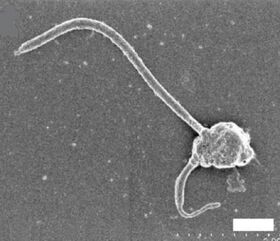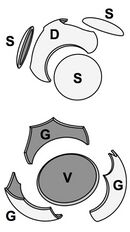Biology:Triparma
| Triparma | |
|---|---|

| |
| The flagellated Triparma eleuthera | |
| Scientific classification | |
| Domain: | Eukaryota
|
| (unranked): | |
| Superphylum: | |
| Phylum: | |
| Class: | |
| Order: | |
| Family: | Triparmaceae
|
| Genus: | Triparma Booth and Marchant 1987
|
| Species | |
| |
| Synonyms | |
| |
Triparma is a genus of unicellular algae in the family Triparmaceae in the order Parmales. They form siliceous plates on the cell surface that aid in identification. Triparma is distinguished by its possession of three shield plates, three triradiate girdle plates, a triradiate girdle plate with notched ends, and a small ventral plate.[1] It was first described by Booth & Marchant in 1987 and the holotype is Triparma columacea.[2]
Triparma cells have two forms: the motile, naked form and the non-motile siliceous form. The motile cells propelled by two flagella of unequal length, typical of heterokonts. The non-motile forms do not possess flagella but instead have a silicified cell wall with a distinctive plate morphology: three shield plates, three oblong girdle plates, a triradiate dorsal plate with rounded ends, and a large ventral plate. Both forms contain a single, dorsal chloroplast that contains chlorophylls a and c1-3 as well as fucoxanthin. They are typically 1-2 μm in size and generally spherical or heart-shaped.[4]
The genus Triparma is actively studied because of their close relationship to the diatoms, and it has been discovered that they have different silica-limitation responses. While diatoms stop growing and cell division is inhibited under low-silica conditions, Triparma continues to grow and divide normally even under nanomolar concentrations of silica, although the silica plates are no longer produced.[5]
Photosynthetic pigments present in bolydophyte chloroplasts include chlorophylls a, c1, c2, c3, fucoxanthin, diatoxanthin, diadinoxanthin.[6]
Synonyms
The genus now includes all species from the non-monophyletic genus Bolidomonas, according to Ichinomiya et al (2016).[4][7]
Taxonomy
- Class Bolidophyceae Guillou & Chretiennot-Dinet 1999[8]
- Order Parmales Booth & Marchant 1987
- Family Triparmaceae Booth & Marchant 1988
- Genus Triparma Booth & Marchant 1987
- Species T. columacea Booth 1987
- Species T. eleuthera Ichinomiya & Lopes dos Santos 2016
- Species T. laevis Booth 1987
- Species T. mediterranea (Guillou & Chrétiennot-Dinet) Ichinomiya & Lopes dos Santos 2016
- Species T. pacifica (Guillou & Chrétiennot-Dinet) Ichinomiya & Lopes dos Santos 2016
- Species T. retinervis Booth 1987
- Species T. strigata Booth 1987
- Species T. verrucosa Booth 1987
- Genus Triparma Booth & Marchant 1987
- Family Triparmaceae Booth & Marchant 1988
- Order Parmales Booth & Marchant 1987
References
- ↑ Konno, Susumu; Jordan, Richard W. (November 2007). "An amended terminology for the Parmales (Chrysophyceae)". Phycologia 46 (6): 612–616. doi:10.2216/07-29.1.
- ↑ 2.0 2.1 Booth, B.C. and Marchant, H.J. (1987) "Parmales, a new order of marine chrysophytes, with descriptions of three new genera and seven new species". Journal of Phycology, 23: 245–260. doi:10.1111/j.1529-8817.1987.tb04132.x.
- ↑ Kuwata, A., Yamada, K., Ichinomiya, M., Yoshikawa, S., Tragin, M., Vaulot, D. and Lopes dos Santos, A. (2018) "Bolidophyceae, a sister picoplanktonic group of diatoms – a review". Frontiers in Marine Science, 5: 370. doi:10.3389/fmars.2018.00370.
 Material was copied from this source, which is available under a Creative Commons Attribution 4.0 International License.
Material was copied from this source, which is available under a Creative Commons Attribution 4.0 International License.
- ↑ 4.0 4.1 Ichinomiya, Mutsuo; dos Santos, Adriana Lopes; Gourvil, Priscillia; Yoshikawa, Shinya; Kamiya, Mitsunobu; Ohki, Kaori; Audic, Stéphane; de Vargas, Colomban et al. (22 March 2016). "Diversity and oceanic distribution of the Parmales (Bolidophyceae), a picoplanktonic group closely related to diatoms". The ISME Journal 10 (10): 2419–2434. doi:10.1038/ismej.2016.38. PMID 27003244. PMC 5030691. http://hal.upmc.fr/hal-01292953/document. Retrieved 10 April 2018.
- ↑ Yamada, Kazumasa; Yoshikawa, Shinya; Ichinomiya, Mutsuo; Kuwata, Akira; Kamiya, Mitsunobu; Ohki, Kaori; Lovejoy, Connie (23 July 2014). "Effects of Silicon-Limitation on Growth and Morphology of Triparma laevis NIES-2565 (Parmales, Heterokontophyta)". PLOS ONE 9 (7): e103289. doi:10.1371/journal.pone.0103289. PMID 25054645.
- ↑ "Comparative Ecophysiology of the Xanthophyll Cycle in Six Marine Phytoplanktonic Species". Protist 160 (3): 397–411. April 2009. doi:10.1016/j.protis.2009.03.001. PMID 19375387.
- ↑ "Genus Detail :: Algaebase". AlgaeBase. http://www.algaebase.org/browse/taxonomy/?id=99210. Retrieved 11 April 2018.
- ↑ M.D. Guiry (2016), AlgaeBase, World-wide electronic publication, National University of Ireland, Galway, http://www.algaebase.org/browse/taxonomy/?id=4320, retrieved 25 October 2016
Wikidata ☰ Q21227150 entry
 |



